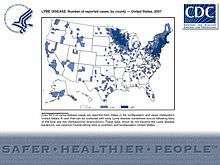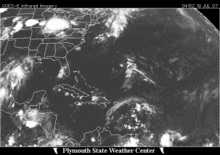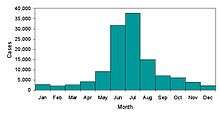Weather and climate effects on Lyme disease exposure
Lyme disease is spread to humans through the bite of infected ticks. The tick population is affected by weather and climate. Many factors determine tick population densities as well as diseased population densities of ticks so that no single factor can determine likelihood of exposure to tick-borne disease.[1] Overall climate[2] and primary host population[3] determine the localities where ticks will thrive. However, studies have been conducted which correlate tick population to climate change and their behavior to weather patterns. Ticks are parasites which carry a myriad of infectious diseases that depend on the species of tick.[4] Overall climate is more determinate of tick population and daily weather has a subtle effect on the spread of tick-borne disease. Being mindful of daily weather patterns and vigilantly avoiding exposure to ticks reduces human exposure to Lyme disease.[5]


Tick entomology
After the larvae have fed, they drop off the host and molt to nymphs. The nymphs then overwinter and their activity almost completely ceases until late spring. They emerge the following year in May, June, and July. This emergence is just before the new generation of larvae hatch, allowing the nymphs to transmit tick-borne disease to new generations of hosts. This increases the possibility that the next generation of larvae will also become infected. Nymphs usually attach and feed on small mammals and birds. After feeding, nymphs drop off and molt to adults that will reappear in the fall of the same year. Adults seek medium to large mammalian hosts, primarily deer. Once adulthood is reached, ticks no longer hibernate during the winter and may become active on warm winter days.[6]
Climate
The incidence of Lyme disease is tied to many factors including climate. Certain regions world-wide supply the proper conditions for ticks to flourish. Ticks like habitats with at least 85% humidity and can only practice host questing at temperatures greater than 7 °C (45 °F).[7] In order to find microclimates that are suitable ticks will use thermoreceptors to detect these proper conditions.[7] One region with especially suitable climate for ticks is the northeastern United States. This region is part of a temperate and humid zone[8] presenting the ideal conditions for tick survival.
Climate change
Climate change could affect ticks in a variety of ways. Süss et al. (2008) lists the following as possible changes to tick populations due to increased temperature brought on by global climate change:[7]
- an acceleration of the ticks developmental cycle
- an extension of the ticks developmental cycle
- an increase in egg production
- an increase in population density
- a shift in risk areas
Many of these changes could potentially increase the Lyme disease incidence and pose a threat to human populations, especially in the eastern half of the United States.
Rainfall and temperature
In addition to climate, seasonal weather variations have a strong effect on tick populations. Changes in temperature and precipitation from year to year affect the Lyme disease incidence. Multiple studies have shown that there is a correlation between the amount of precipitation and the incidence of Lyme disease. After nymph ticks feed on and infect their host with Lyme disease they lose their ability to effectively control their water content.[9] During a year with very little precipitation many ticks may die following feeding because of this loss of water regulatory control.[9] These nymph ticks that have died out will never reach adulthood and lay eggs. Two years later their offspring nymph tick population will be reduced and thus Lyme disease incidence will also decrease.[9] Schauber et. Al. (2005) also suggests a similar tie between lagged precipitation as measured by the Palmer Hydrologic Drought Index and Lyme disease incidence in the northeastern United States.[10]
In addition to direct effects on nymph tick populations summer precipitation may also be a factor for controlling the population of the ticks’ primary host – the white footed mouse.[9] Decreased rainfall in the summer months may also decrease the amount of vegetation available for mice populations to eat in order to sustain themselves during the winter.[11] It thus follows that a decrease in rainfall may decrease the population of the ticks’ primary host and thus reduce tick populations and Lyme disease incidence.
Subak (2003) proposes that a link between human behavior and precipitation could be another factor in Lyme disease incidence.[9] In the northeastern United States when the summer weather is especially hot and dry, it may disincline people from outdoor activity.[9] In fact, Subak (2003) found a link between dry conditions and a decreased Lyme disease incidence during late summer months in the northeast United States.[9]
Temperature may also play a role in Lyme disease incidence. Schauber et al. (2005) found a positive correlation between the mean summer temperature and the rate of Lyme disease in the northeastern United States.[10] Additionally, Subak (2003) suggests that there may also be a relationship between warmer winters and increased Lyme disease.[9] This study discovered a tentative link between warmer winter weather lagged one year and Lyme disease incidence.[9] A more moderate winter may increase the survival of the White-footed Mouse host allowing for increased tick populations in the spring and summer.[9] These warmer winter temperatures may also allow for more adult tick activity during winter and cause an increase in nymph populations the following year.[9]
Risk

Vulnerability to Lyme
Outdoor activities tend to take place under fair weather conditions, which are those that ticks thrive in.[12] Populations of the nymphal stage, the stage which most commonly transmits Lyme to humans,[13] are highest during the late spring and early summer,[13] directly preceding the months when greatest number of reported cases of Lyme disease occur.[14]
Typical summer outerwear consists of shorter garments that enable ticks greater exposure to skin. Tick saliva has immunosuppressive properties[15] that shut off the body’s response, which would alert the body to the ticks’s presence. This allows ticks to remain attached for an extended period of time while feeding, increasing the probability of disease transmission.[16]
Mitigating exposure
A number of different methods have been shown to mitigate exposure to Lyme disease. Individuals who practice diligence in ticks removal and exposure reduction techniques will be resilient to the risks of contracting Lyme disease,[17] but further risk reduction can be attained by observance of the daily weather since ticks use a number of host seeking techniques that the weather can affect.[18] ticks are able to detect hosts by their shadow.[18] On bright sunny days, shadows contrast greatly with the surrounding brightly lit areas.[19] Wearing light colored clothing on these days reduces risk of ticks exposure by reducing the contrast. Conducting outdoor activities on overcast or slightly foggy days also reduces shadow detection since contrast with the surroundings is minimized.[19]
Ticks can detect the odor of a host.[18] On breezy days remaining downwind from prime ticks habitats will minimize scent detection.[20] Ticks seek hosts only at temperatures above 7 °C (45 °F).[7] Risk of exposure at temperatures below these is extremely minimal.
References
- ↑ Ginsberg, Howard S., Eric L. Rulison, Lorenza Beati, Russell Burke, Graham J. Hickling, Kaetlyn Kerr, Isis Kuczaj, Roger A. LeBrun, Genevieve Pang, Cathy Scott, and Jean I. Tsao. Effects of Environmental Variables on Abundance and Phenology of Immature Ixodes Scapularis (Acari: Ixodidae). http://www.nps.gov/caco/naturescience/upload/Ginsberg_Poster.pdf. National Park Service. Web. 30 November 2011.
- ↑ Frans Jongejan, Frans. "Ticks, Diseases and Climate Change". http://www.rtcc.org/2007/html/res_edu_uou.html. Utrecht Centre for Tick-borne Diseases. 2007. Retrieved 2011-11-28.
- ↑ N.L. Breisch, N.L. and Thorne, B.L.. "Lyme Disease and the Deer Tick in Maryland". Maryland Cooperative Extension Fact Sheet 595. http://extension.umd.edu/publications/pdfs/fs595.pdf. 2001. Retrieved 2011-11-30.
- ↑ "Ticks : Environmental Health : NYC DOHMH." New York City Department of Health and Mental Hygiene. http://www.nyc.gov/html/doh/html/ehs/ehstick.shtml. 2011. Web. 30 November 2011.
- ↑ "Ticks | Health Department | City of Alexandria, VA." City of Alexandria, Virginia. http://alexandriava.gov/health/info/default.aspx?id=27984. City of Alexandria Health Department, 28 June 2011. Web. 30 Nov. 2011.
- ↑ Stafford III, Kirby C. "Tick Management Handbook." Maine Medical Center Research Institute. The Connecticut Agricultural Experiment Station, 2007. http://www.ct.gov/caes/lib/caes/documents/publications/bulletins/b1010.pdf. Web. 10 Dec. 2011.
- 1 2 3 4 Süss J, Klaus C, Gerstengarbe FW, Werner PC (2008). "What makes ticks tick? Climate change, ticks, and tick-borne diseases.". J Travel Med. 15 (1): 39–45. PMID 18217868. doi:10.1111/j.1708-8305.2007.00176.x.
- ↑ Major Biomes Map. Soil climate map, USDA-NRCS, Soil Survey Division, World Soil Resources, Washington D.C. (1999). http://soils.usda.gov/use/worldsoils/mapindex/biomes.html. Accessed 11 Dec. 2011.
- 1 2 3 4 5 6 7 8 9 10 11 Subak, Susan. Effects of Climate on Variability in Lyme Disease Incidence in the Northeastern United States. American Journal of Epidemiology , Vol. 105, No. 6 (2003): 531–538.
- 1 2 Schauber, Eric M. Richard S. Ostfeld and Andrew S. Evans, Jr. What Is the Best Predictor of Annual Lyme Disease Incidence: Weather, Mice, or Acorns? Ecological Applications , Vol. 15, No. 2 (Apr., 2005): 575–586
- ↑ Jones, C.J. and U.D. Kitron. Populations of Ixodes scapularis (Acari: Ixodidae) Are Modulated by Drought at a Lyme Disease Focus in Illinois. Journal of Mecial Entomology, Vol 37, No. 3 (2000): 408–415
- ↑ "Making Lyme Disease Take a Hike." Advance for Nurse Practitioners June (2001): 116. Nurse Practitioners and Physicians Assistants. http://nurse-practitioners-and-physician-assistants.advanceweb.com/sharedresources/advancefornp/resources/DownloadableResources/np_0601_lyme.pdf. Web. 5 Dec. 2011.
- 1 2 "CDC – Transmission – Lyme Disease." Centers for Disease Control and Prevention. http://www.cdc.gov/lyme/transmission/index.html. 12 Apr. 2011. Web. 5 Dec. 2011.
- ↑ "CDC – Cases by State – Lyme Disease." Centers for Disease Control and Prevention. http://www.cdc.gov/lyme/stats/chartstables/casesbymonth.html. 9 Sept. 2010. Web. 5 Dec. 2011.
- ↑ Kotsyfakis, M. "Antiinflammatory and Immunosuppressive Activity of Sialostatin L, a Salivary Cystatin from the Tick Ixodes Scapularis." Journal of Biological Chemistry 281.36 (2006): 26298–6307. Print.
- ↑ "Lyme Disease." American Lyme Disease Foundation. http://www.aldf.com/lyme.shtml. 26 Apr. 2010. Web. 5 Dec. 2011.
- ↑ "CDC – Tick-Borne Diseases – NIOSH Workplace Safety and Health Topic." Centers for Disease Control and Prevention. http://www.cdc.gov/niosh/topics/tick-borne/. 22 Sept. 2011. Web. 5 Dec. 2011.
- 1 2 3 "CDC – Tick Life Cycle and Hosts – Ticks." Centers for Disease Control and Prevention. http://www.cdc.gov/ticks/life_cycle_and_hosts.html. 8 Mar. 2011. Web. 5 Dec. 2011.
- 1 2 Hale, Nathan Cabot. Abstraction in Art and Nature. New York: Dover, 1993. Print.
- ↑ National Resource Council. Odors from Stationary and Mobile Sources. Washington, 1979.